Honor Award
The Overlapped City
Chen Chen, Student ASLA, Graduate, Harvard Graduate School of Design
Faculty Advisors: Philipp Oswalt; Theo Deutinger
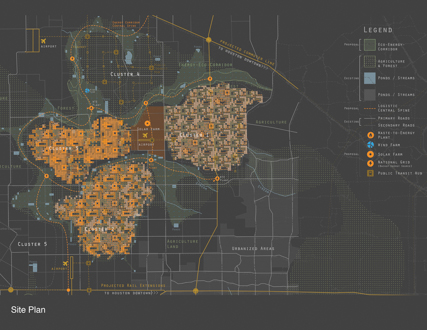 238
238
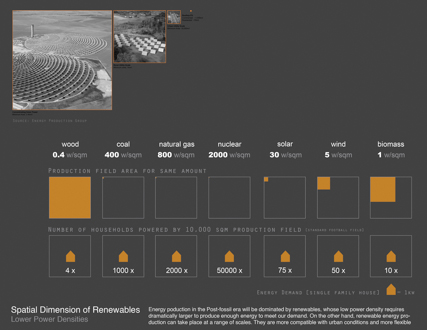 Close Me!
Close Me!Spatial Dimension of Renewables
Energy production in the Post-fossil era will be dominated by renewables, whose low power density requires dramatically larger to produce enough energy to meet our demand. On the other hand, renewable energy production can take place at a range of scales. They are more compatible with urban conditions and more flexible with spatial application than fossil fuel based energy production. Their distributed production pattern could take advantage of micro grid, a more efficient,resilient distribution.
Download Hi-Res ImageImage: Chen Chen
Image 2 of 15
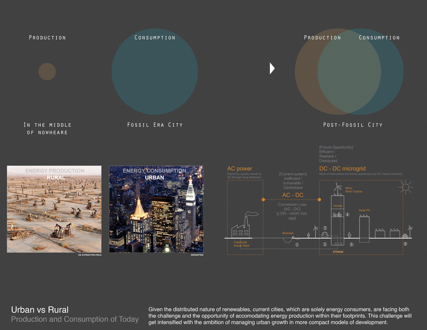 Close Me!
Close Me!Urban Vs Rural
Given the distributed nature of renewables, current cities, which are solely energy consumers, are facing both the challenge and the opportunity of accommodating energy production within their footprints. This challenge will get intensified with the ambition of managing urban growth in more compact models of development.
Download Hi-Res ImageImage: Chen Chen
Image 3 of 15
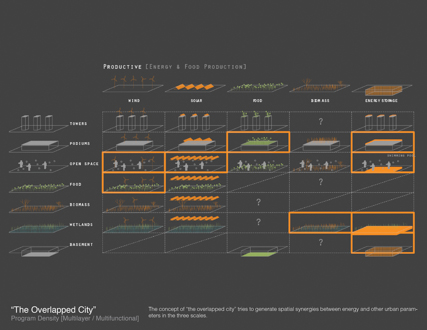 Close Me!
Close Me!The Overlapped City
The concept of “the overlapped city” tries to generate spatial synergies between energy and other urban parameters in the three scales.
Download Hi-Res ImageImage: Chen Chen
Image 4 of 15
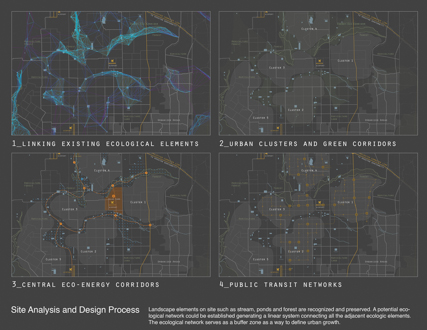 Close Me!
Close Me!Site Analysis and Design Process
Landscape elements on site such as stream, ponds and forest are recognized and preserved. A potential ecological network could be established generating a linear system connecting all the adjacent ecologic elements. The ecological network serves as a buffer zone as a way to define urban growth.
Download Hi-Res ImageImage: Chen Chen
Image 5 of 15
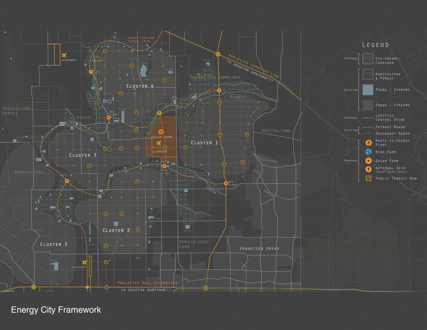
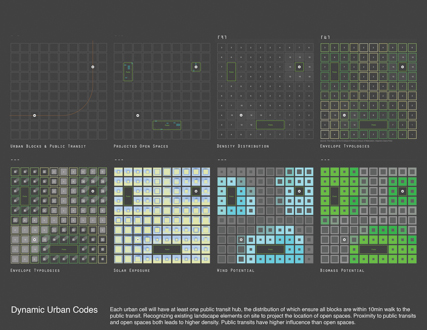 Close Me!
Close Me!Dynamic Urban Codes
Each urban cell will have at least one public transit hub, the distribution of which ensure all blocks are within 10min walk to the public transit. Recognizing existing landscape elements on site to project the location of open spaces. Proximity to public transits and open spaces both leads to higher density. Public transits have higher influence than open spaces.
Download Hi-Res ImageImage: Chen Chen
Image 7 of 15
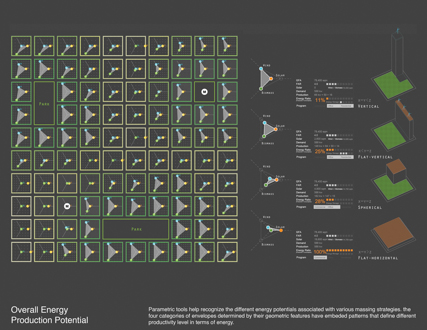 Close Me!
Close Me!Overall Energy Production Potential
Parametric tools help recognize the different energy potentials associated with various massing strategies. the four categories of envelopes determined by their geometric features have embedded patterns that define different productivity level in terms of energy.
Download Hi-Res ImageImage: Chen Chen
Image 8 of 15
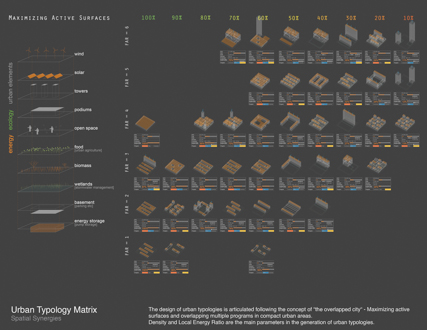 Close Me!
Close Me!Urban Typology Matrix
The design of urban typologies is articulated following the concept of “the overlapped city“ - Maximizing active surfaces and overlapping multiple programs in compact urban areas. Density and Local Energy Ratio are the main parameters in the generation of urban typologies.
Download Hi-Res ImageImage: Chen Chen
Image 9 of 15
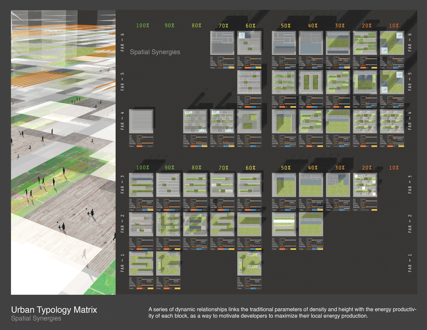 Close Me!
Close Me!Urban Typology Matrix
A series of dynamic relationships links the traditional parameters of density and height with the energy productivity of each block, as a way to motivate developers to maximize their local energy production.
Download Hi-Res ImageImage: Chen Chen
Image 10 of 15
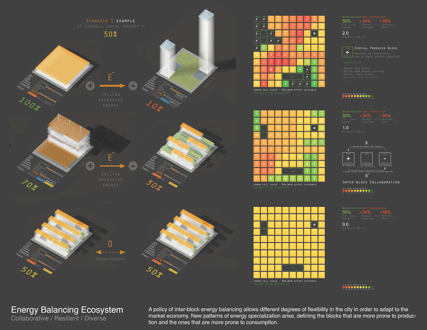 Close Me!
Close Me!Energy Balancing Ecosystem
A policy of inter-block energy balancing allows different degrees of flexibility in the city in order to adapt to the market economy. New patterns of energy specialization arise, defining the blocks that are more prone to production and the ones that are more prone to consumption.
Download Hi-Res ImageImage: Chen Chen
Image 11 of 15
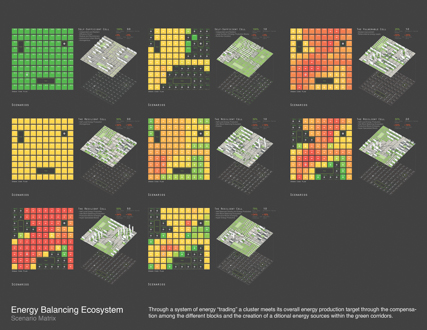 Close Me!
Close Me!Energy Balancing Ecosystem
Through a system of energy “trading” a cluster meets its overall energy production target through the compensation among the different blocks and the creation of a additional energy sources within the green corridors.
Download Hi-Res ImageImage: Chen Chen
Image 12 of 15
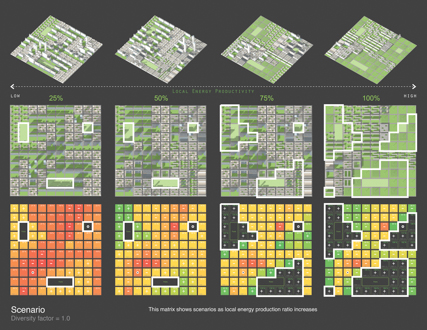 Close Me!
Close Me!Scenarios
This matrix shows scenarios as local energy production ration increases
Download Hi-Res ImageImage: Chen Chen
Image 13 of 15
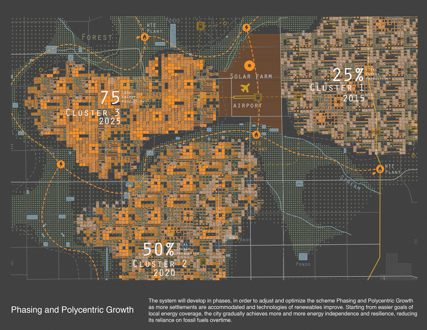 Close Me!
Close Me!Phasing and Polycentric Growth
The system will develop in phases, in order to adjust and optimize the scheme Phasing and Polycentric Growth as more settlements are accommodated and technologies of renewables improve. Starting from easier goals of local energy coverage, the city gradually achieves more and more energy independence and resilience, reducing its reliance on fossil fuels overtime.
Download Hi-Res ImageImage: Chen Chen
Image 14 of 15
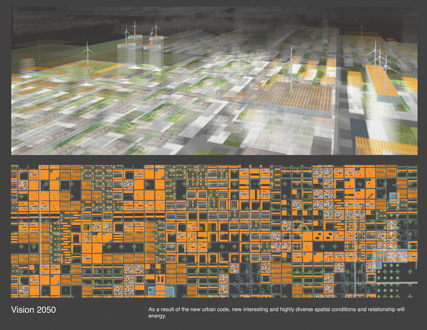 Close Me!
Close Me!Vision 2050
As a result of the new urban code, new interesting and highly diverse spatial conditions and relationship will energy.
Download Hi-Res ImageImage: Chen Chen
Image 15 of 15
Project Statement
In the new era, the logic of energy production and distribution will start having a significant impact on the spatial organization of the urban growth. This project explores the morphology of resilient post-fossil cities across three scales: redefining urban boundaries and urban clusters, energy infrastructure framework and a new set of urban codes. The concept of “the overlapped city” tries to generate spatial synergies between energy and other urban parameters in the three scales.
Project Narrative
Energy production in the post-fossil era will be dominated by renewables.
Even though renewable energy has a low power density that requires dramatically larger areas to meet our cities demand, it is more compatible with urban conditions and more flexible with spatial application than fossil fuel based systems. Furthermore, renewable energy production can take place at various scales and its distributed production pattern can take advantage of the micro-grid, a more efficient and resilient distribution mode.
Current cities, which are solely energy consumers, are facing both the challenge and the opportunity of accommodating energy production within their footprints. This challenge will be even bigger with the ambition of managing urban growth in more compact models of development.
Historically, political, religious and geographic agents have defined our cities. . In the new era, the logic of energy production and distribution will start having a significant impact on the spatial organization of the urban growth. This project explores the morphology of resilient post-fossil cities across three scales: redefining urban boundaries and urban clusters, energy infrastructure framework and a new set of urban codes. The concept of “the overlapped city” tries to generate spatial synergies between energy and other urban parameters in the three scales.
The testing site is in west Houston, the fastest growing urban area in the US, with a rich potential for renewable energy production.
Parametric tools help recognize the different energy potentials associated with various massing strategies. A series of dynamic relationships links the traditional parameters of density and height with the energy productivity of each block, as a way to motivate developers to maximize their local energy production. The design of urban typologies is articulated following the concept of “overlapped city”- maximizing active surfaces and overlapping multiple programs in compact urban areas.
A policy of inter-block energy balance incentivizes the citizens to maximize their local energy production and reduce their reliance on the centralized energy supply, making the new city work as a resilient ecosystem. In such context, different degrees of flexibility can be allowed in order to adapt to the market economy. New patterns of energy specialization arise, defining the blocks that are more prone to production and the ones that are more prone to consumption. Through a system of energy “trading” a cluster meets its overall energy production target through the compensation among the different blocks and the creation of additional energy sources within the green corridors.
As a result of the new urban code, some new interesting and highly diverse spatial conditions and relationships arise, disclosing the potential of this approach to create new paradigms of urbanization. A variety of radically different scenarios are therefore generated, tested and evaluated.
Additional Project Credits
Praveen Subramani
Nicola Saladino
Zak Accuardi




